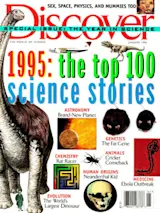David Noble didn’t know he was going to make international headlines when he casually decided to explore a 2,000-foot-deep gorge in Wollemi National Park, about 100 miles outside Sydney, Australia. But the park ranger also didn’t know, on that day in August 1994, that he was going to stumble on about 40 trees whose likes may not have been seen elsewhere for millions of years. The trees (the crown of an adult is shown) have cones, which mark them as pines, but they also have a unique, spongy bark. And when they’re young, they have leaves that look like fern fronds. Taxonomist Ken Hill of the Royal Botanic Gardens in Sydney and his co- workers reported this past year that both the cones and the DNA of the Wollemi pine place it in a family that includes pines such as the Chilean monkey puzzle tree and the New Zealand kauri pine. The tree doesn’t fit into a living genus of this family, however; the closest analogue, according to Hill, appears to be fossils of trees that lived 90 to 50 million years ago, in the Cretaceous and Tertiary Periods. Its nearest known relatives are all fossils, rather than anything living today, Hill says. It’s the last surviving member of a line.
Cretaceous Park
Discover Wollemi National Park, where the unique Wollemi pine reveals secrets from the Cretaceous and Tertiary Periods.
More on Discover
Stay Curious
SubscribeTo The Magazine
Save up to 40% off the cover price when you subscribe to Discover magazine.
Subscribe













